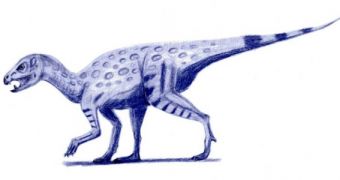These dinosaur fossils are very scarce and difficult to come by, as evidenced by the fact that only two were discovered until recently, both adults and both in South Africa. But now, a post-doctoral student at the University of Chicago has found the skull of a juvenile heterodontosaurus, which was able to supply more answers to anthropologists, as well as more mysteries regarding the animals' diet and behavior.
Thus far, they were believed to be omnivorous, in that they ate both vegetation and smaller insects or animals. However, the main idea was that they ate plants primarily, and other creatures were just additions to their menu. Now, it seems that the newly-discovered fossil is a missing link between its meat-eating predecessors and its highly-evolved herbivorous offspring. Apparently, the small creature, sizing only 3 feet (1 meter) when fully matured, was the predecessor of "modern" plant eaters that eventually grew to be tens of feet in size and weigh more than 80 tones.
The dinosaur's name, which is Latin for "different-toothed lizard," was placed under more intense scrutiny with this new find, due to the fact that researchers discovered that the animal wasn't in the habit of changing its teeth very often, which is highly unusual for dinosaurs and their followers, such as modern-day crocodiles. Nowadays, only mammals and humans change their teeth once or twice in their lives.
This adaptation to the environment allowed this species to develop teeth that were tightly enclosed into the mouth and form denture. Dinosaurs usually had gaps between their teeth, which allowed them to change them regularly. As food was bony and the vegetation solid, they had to have fresh teeth ready to grind anything they ate at all times.
The fact that the small lizard lacked this ability and developed denture left scientists in the dark. "Tooth replacement must have occurred during growth, however, evidence of continuous tooth replacement appears to be absent, in both adult and juvenile specimens," said the authors of the study, detailing the find. Hopefully, further investigations will determine exactly how this small dinosaur fed and if it is, in fact, the missing link between herbivores and carnivores everyone is looking for.

 14 DAY TRIAL //
14 DAY TRIAL //